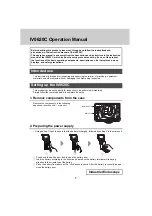
15
EN
KAT R Type and T Type Tonometer by KEELER
Cause:
Excessive pressure has been applied.
Correction:
Reduce pressure until the semicircular
images come closer together and finally
the inner margins align with each other, as
shown in the last illustration.
Correct final position
The inner margins of the fluorescein
semicircular images are aligned and
touching each other.
8. GENERAL INFORMATION AND SUGGESTIONS CONCERNING
MEASUREMENT
IMPORTANT NOTE
Measurement must be performed as quickly as possible on each eye. Should epithelial drying
be observed, we recommend the patient’s acuity and visual fields should be examined.
The pressure measurement procedure may be repeated several times. Nervous or anxious
patients often have higher intraocular pressure during the first measurement procedure.
It has been found that pressure decreases during the first few minutes of the procedure, when
the patient realises that the tonometric examination does is not unpleasant. When correctly
anaesthetised and with their eyes fully open, the patient will feel absolutely nothing. Therefore
we recommend running a preliminary measurement procedure on each eye, the results of
which need not be taken into consideration. After completing the preliminary procedure, run
three measurement procedures on each eye. These readings will be correct if the pressure has
stabilised. When the measurement procedures are performed correctly, the results of the
subsequent measurements will vary by only about 0,5 mmHg.
When the measurement procedure for one eye is prolonged excessively, a drying phenomena
will occur on the corneal epithelium of both eyes.
A ring of fluorescent deposits will form around the cornea contact surface and around the
measuring prism on the eye being examined. The other eye will show fluorescent dry areas,
resembling a map, which will hinder and make measurement unreliable.
The eye will rapidly recover from any corneal dryness without the need for any treatment, visual
acuity may be temporarily affected by fine epithelial defects.
Summary of Contents for KAT R
Page 1: ...Keeler Applanation Tonometer KAT R type and T type INSTRUCTIONS FOR USE EN HY RU...
Page 2: ......
Page 3: ...EN HY RU KAT R T 22 KAT R Type and T Type Tonometer Instructions For Use 1 KAT R 43...
Page 4: ......
Page 30: ...26 HY KEELER KAT R T 3 1 Keeler WEEE 2 2...
Page 31: ...27 HY KEELER KAT R T 3 3 1 1 2 70 2 3 4 3 2 1 2 1 1 3 4 10 30...
Page 32: ...28 HY KEELER KAT R T 10 10 30 Pantasept 3 10 3 10 10 10 5 6 60 C 4...
Page 34: ...30 HY KEELER KAT R T 4 60 5 Keeler Fixed R 1 2 3 4 60 5 6 2 0 5 1 2 R T...
Page 35: ...31 HY KEELER KAT R T 60 C 6 3 10X 60 0 5 3 0 Pantasept 3 1...
Page 36: ...32 HY KEELER KAT R T 6 4 10 6 5 1 1 2 1 10 0 3 1...
Page 37: ...33 HY KEELER KAT R T 7 7 1 2...
Page 38: ...34 HY KEELER KAT R T 7 2 7 3...
Page 39: ...35 HY KEELER KAT R T 7 4...
Page 40: ...36 HY KEELER KAT R T 8 0 5...
Page 42: ...38 HY KEELER KAT R T 10 1 0 0 05 3 0 05 4 10 2 2 5 5 0 2 6 0 2 5 2 1 95 2 05 0 0 3 4 0 2 6 5...
Page 43: ...39 HY KEELER KAT R T 1 95 2 6 2 05 2 7 6 6 5 9 6 1 6 2 2 6 7 6 6 8 9 11 Keeler Keeler Keeler...
Page 46: ...42 HY KEELER KAT R T 15 B2B 01691 676124 44 1691 676124...
Page 51: ...47 KEELER KAT R RU 3 1 Keeler WEEE 2 2...
Page 52: ...48 KEELER KAT R RU 3 3 1 1 2 70 2 3 4 3 2 1 2 1 1 3 4 10 30...
Page 53: ...49 KEELER KAT R RU 10 10 30 Pantasept 3 10 3 10 10 10 5 6 60 4...
Page 55: ...51 KEELER KAT R RU 4 60 5 Keeler R 1 2 3 4 60 5 6 2 0 5 1 2 R...
Page 56: ...52 KEELER KAT R RU 60 6 3 10X 60 Pantasept 0 5 3 0 3 1...
Page 57: ...53 KEELER KAT R RU 6 4 10 6 5 1 1 2 1 10 0 3 1...
Page 58: ...54 KEELER KAT R RU 7 7 1 2...
Page 59: ...55 KEELER KAT R RU 7 2 7 3...
Page 60: ...56 KEELER KAT R RU 7 4...
Page 61: ...57 KEELER KAT R RU 8 0 5...
Page 63: ...59 KEELER KAT R RU 10 1 0 0 05 3 0 05 4 10 2 2 5 5 0 2 6 0 2 5 2 1 95 2 05 0 0 3 4 0 2 6 5...
Page 64: ...60 KEELER KAT R RU 1 95 2 6 2 05 2 7 6 6 5 9 6 1 6 2 2 6 7 6 6 8 9 11 Keeler Keeler Keeler...
Page 67: ...63 KEELER KAT R RU 15 01691 676124 44 1691 676124...
















































